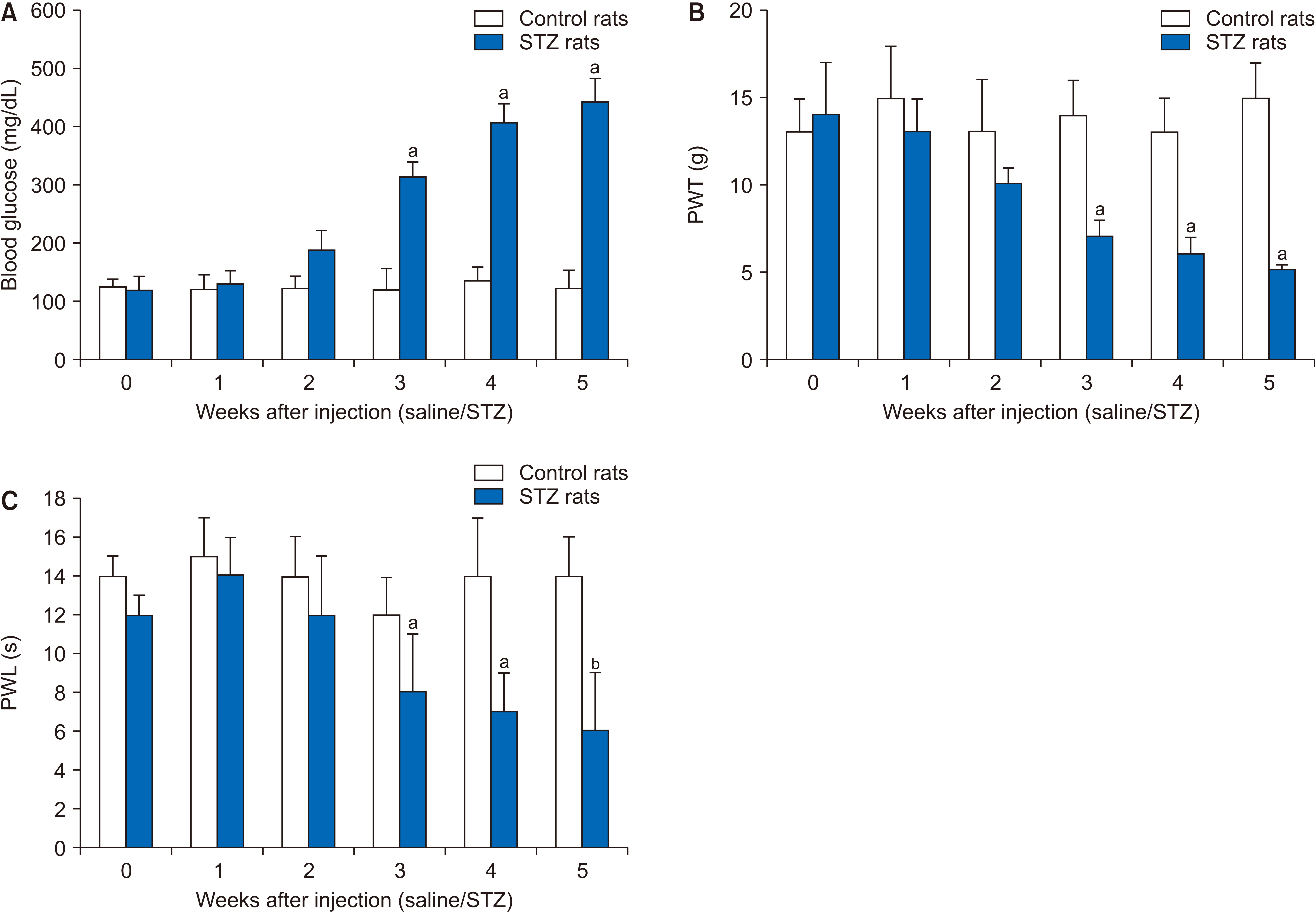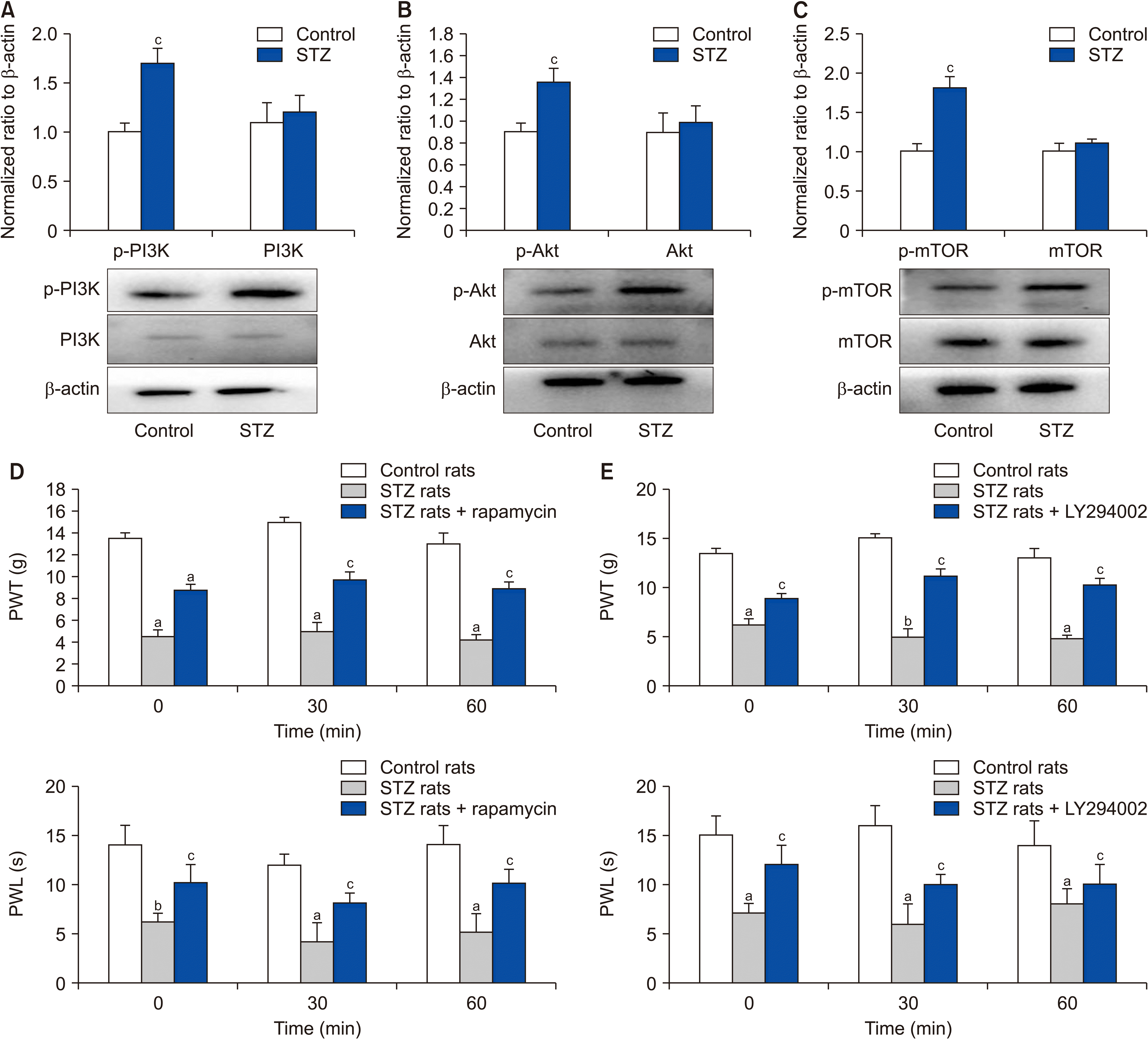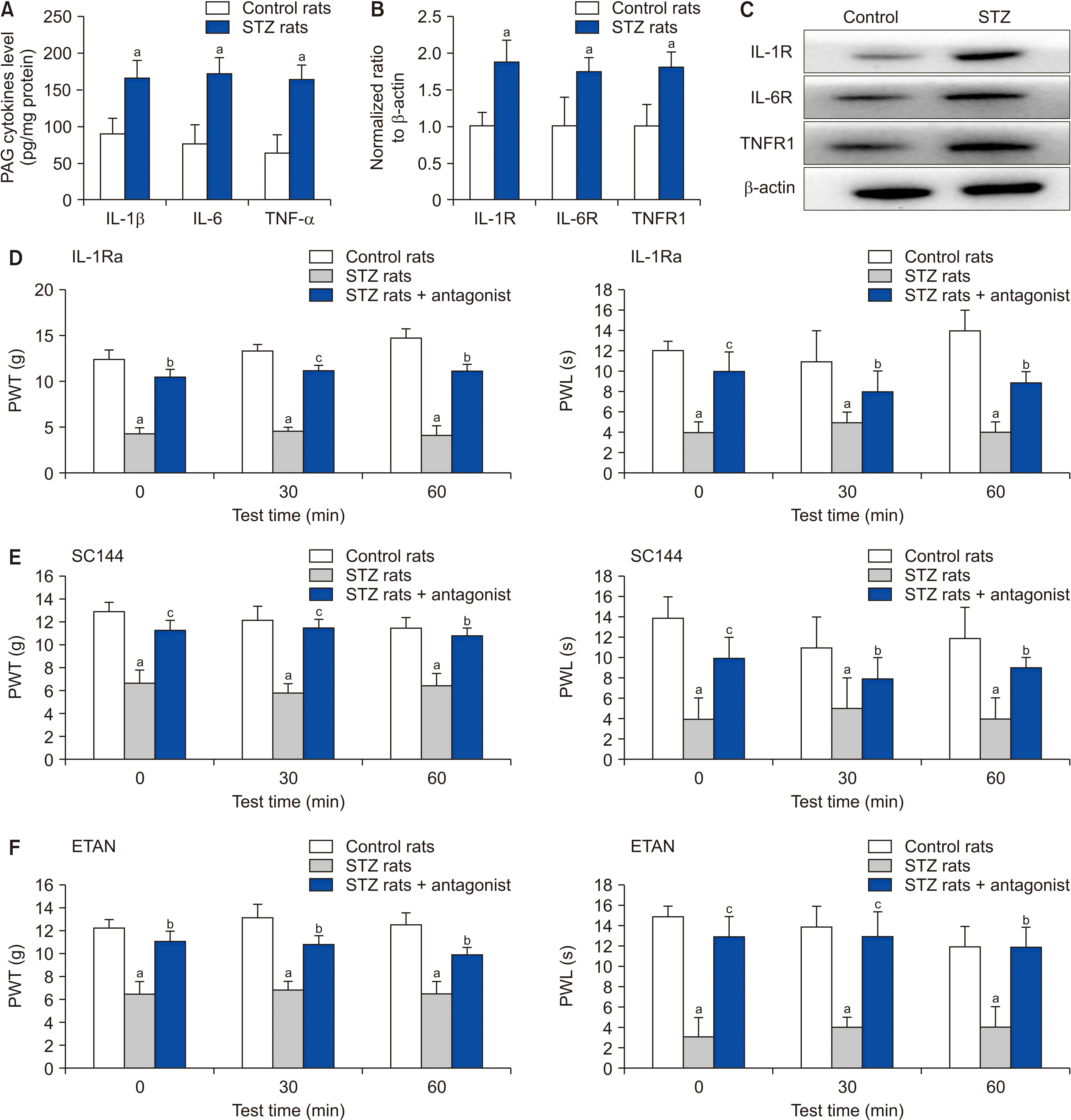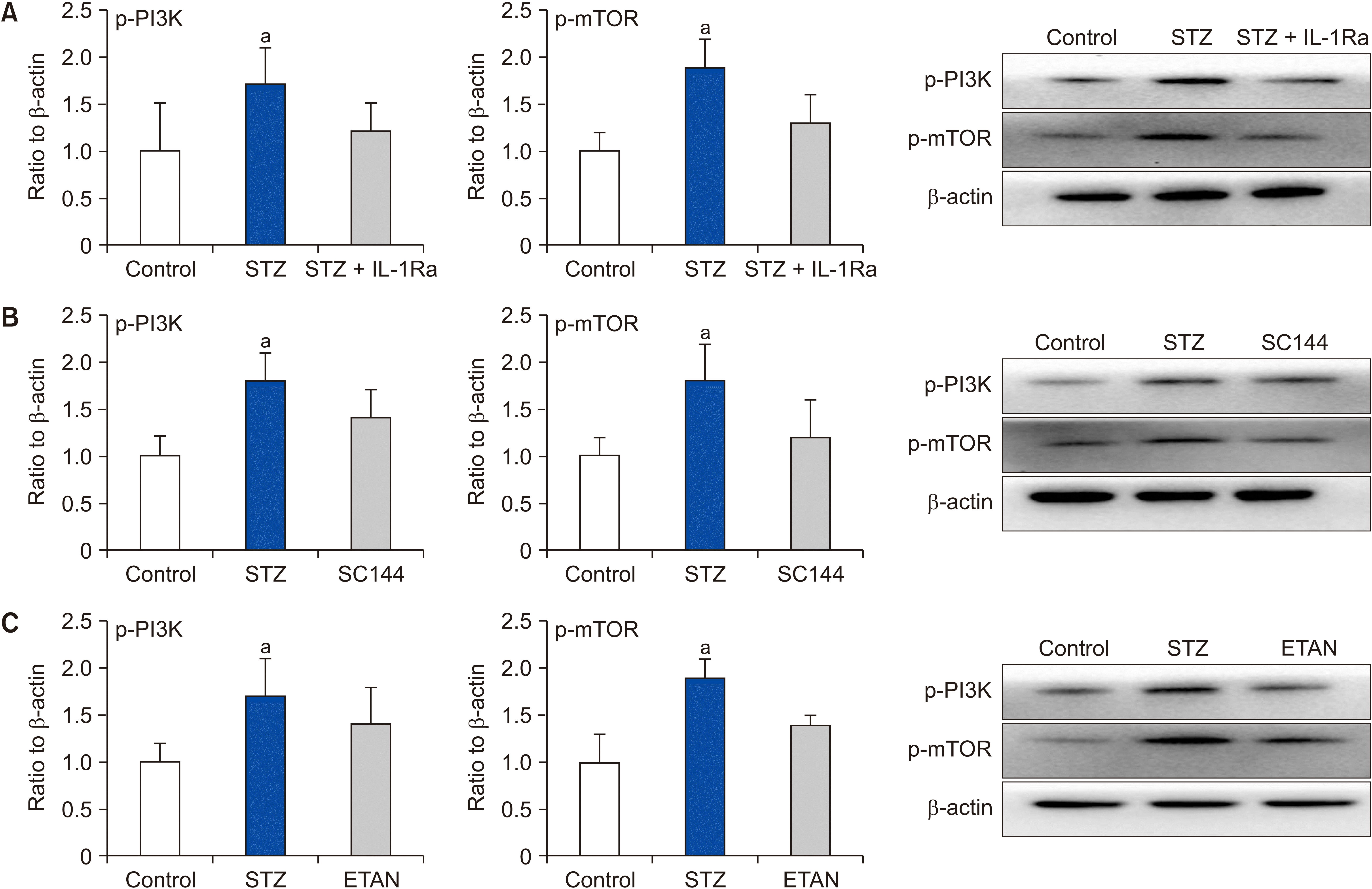1. Vinik AI. 2016; Clinical practice. Diabetic sensory and motor neuropathy. N Engl J Med. 374:1455–64. DOI:
10.1056/NEJMcp1503948. PMID:
27074068.
2. Armstrong DG, Boulton AJM, Bus SA. 2017; Diabetic foot ulcers and their recurrence. N Engl J Med. 376:2367–75. DOI:
10.1056/NEJMra1615439. PMID:
28614678.

3. Ji RR, Nackley A, Huh Y, Terrando N, Maixner W. 2018; Neuroinflammation and central sensitization in chronic and widespread pain. Anesthesiology. 129:343–66. DOI:
10.1097/ALN.0000000000002130. PMID:
29462012. PMCID:
PMC6051899.

4. Morgado C, Terra PP, Tavares I. 2010; Neuronal hyperactivity at the spinal cord and periaqueductal grey during painful diabetic neuropathy: effects of gabapentin. Eur J Pain. 14:693–9. DOI:
10.1016/j.ejpain.2009.11.011. PMID:
20056558.

5. Morgado C, Silva L, Pereira-Terra P, Tavares I. 2011; Changes in serotoninergic and noradrenergic descending pain pathways during painful diabetic neuropathy: the preventive action of IGF1. Neurobiol Dis. 43:275–84. DOI:
10.1016/j.nbd.2011.04.001. PMID:
21515376.

6. Lisi L, Aceto P, Navarra P, Dello Russo C. 2015; mTOR kinase: a possible pharmacological target in the management of chronic pain. Biomed Res Int. 2015:394257. DOI:
10.1155/2015/394257. PMID:
25685786. PMCID:
PMC4313067.

7. Santini E, Huynh TN, Klann E. 2014; Mechanisms of translation control underlying long-lasting synaptic plasticity and the consolidation of long-term memory. Prog Mol Biol Transl Sci. 122:131–67. DOI:
10.1016/B978-0-12-420170-5.00005-2. PMID:
24484700. PMCID:
PMC6019682.

8. Guo JR, Wang H, Jin XJ, Jia DL, Zhou X, Tao Q. 2017; Effect and mechanism of inhibition of PI3K/Akt/mTOR signal pathway on chronic neuropathic pain and spinal microglia in a rat model of chronic constriction injury. Oncotarget. 8:52923–34. DOI:
10.18632/oncotarget.17629. PMID:
28881783. PMCID:
PMC5581082.

9. Price TJ, Rashid MH, Millecamps M, Sanoja R, Entrena JM, Cervero F. 2007; Decreased nociceptive sensitization in mice lacking the fragile X mental retardation protein: role of mGluR1/5 and mTOR. J Neurosci. 27:13958–67. DOI:
10.1523/JNEUROSCI.4383-07.2007. PMID:
18094233. PMCID:
PMC2206543.

10. Xu Q, Fitzsimmons B, Steinauer J, O'Neill A, Newton AC, Hua XY, et al. 2011; Spinal phosphinositide 3-kinase-Akt-mammalian target of rapamycin signaling cascades in inflammation-induced hyperalgesia. J Neurosci. 31:2113–24. DOI:
10.1523/JNEUROSCI.2139-10.2011. PMID:
21307248. PMCID:
PMC3097059.

11. Asante CO, Wallace VC, Dickenson AH. 2009; Formalin-induced behavioural hypersensitivity and neuronal hyperexcitability are mediated by rapid protein synthesis at the spinal level. Mol Pain. 5:27. DOI:
10.1186/1744-8069-5-27. PMID:
19500426. PMCID:
PMC2699332.

13. Li JN, Sheets PL. 2018; The central amygdala to periaqueductal gray pathway comprises intrinsically distinct neurons differentially affected in a model of inflammatory pain. J Physiol. 596:6289–305. DOI:
10.1113/JP276935. PMID:
30281797. PMCID:
PMC6292805.

14. Mills EP, Di Pietro F, Alshelh Z, Peck CC, Murray GM, Vickers ER, et al. 2018; Brainstem pain-control circuitry connectivity in chronic neuropathic pain. J Neurosci. 38:465–73. DOI:
10.1523/JNEUROSCI.1647-17.2017. PMID:
29175957. PMCID:
PMC6596109.

16. Shabab T, Khanabdali R, Moghadamtousi SZ, Kadir HA, Mohan G. 2017; Neuroinflammation pathways: a general review. Int J Neurosci. 127:624–33. DOI:
10.1080/00207454.2016.1212854. PMID:
27412492.

17. Gwak YS, Hulsebosch CE, Leem JW. 2017; Neuronal-glial interactions maintain chronic neuropathic pain after spinal cord injury. Neural Plast. 2017:2480689. DOI:
10.1155/2017/2480689. PMID:
28951789. PMCID:
PMC5603132.

18. Yang Y, Zhang Z, Guan J, Liu J, Ma P, Gu K, et al. 2016; Administrations of thalidomide into the rostral ventromedial medulla alleviates painful diabetic neuropathy in Zucker diabetic fatty rats. Brain Res Bull. 125:144–51. DOI:
10.1016/j.brainresbull.2016.06.013. PMID:
27346278.

19. Goyal SN, Reddy NM, Patil KR, Nakhate KT, Ojha S, Patil CR, et al. 2016; Challenges and issues with streptozotocin-induced diabetes - a clinically relevant animal model to understand the diabetes pathogenesis and evaluate therapeutics. Chem Biol Interact. 244:49–63. DOI:
10.1016/j.cbi.2015.11.032. PMID:
26656244.

20. Swanson LW. 2018; Brain maps 4.0-structure of the rat brain: an open access atlas with global nervous system nomenclature ontology and flatmaps. J Comp Neurol. 526:935–43. DOI:
10.1002/cne.24381. PMID:
29277900. PMCID:
PMC5851017.

21. Um SW, Kim MJ, Leem JW, Bai SJ, Lee BH. 2019; Pain-relieving effects of mTOR inhibitor in the anterior cingulate cortex of neuropathic rats. Mol Neurobiol. 56:2482–94. DOI:
10.1007/s12035-018-1245-z. PMID:
30032425. PMCID:
PMC6459802.

22. Fischer TZ, Waxman SG. 2010; Neuropathic pain in diabetes--evidence for a central mechanism. Nat Rev Neurol. 6:462–6. DOI:
10.1038/nrneurol.2010.90. PMID:
20625378.

23. Bogush M, Heldt NA, Persidsky Y. 2017; Blood brain barrier injury in diabetes: unrecognized effects on brain and cognition. J Neuroimmune Pharmacol. 12:593–601. DOI:
10.1007/s11481-017-9752-7. PMID:
28555373. PMCID:
PMC5693692.

25. Tortorici V, Morgan MM. 2002; Comparison of morphine and kainic acid microinjections into identical PAG sites on the activity of RVM neurons. J Neurophysiol. 88:1707–15. DOI:
10.1152/jn.2002.88.4.1707. PMID:
12364500.

26. Guo J, Fu X, Cui X, Fan M. 2015; Contributions of purinergic P2X3 receptors within the midbrain periaqueductal gray to diabetes-induced neuropathic pain. J Physiol Sci. 65:99–104. DOI:
10.1007/s12576-014-0344-5. PMID:
25367719.

27. Zhuang X, Chen Y, Zhuang X, Chen T, Xing T, Wang W, et al. 2016; Contribution of pro-inflammatory cytokine signaling within midbrain periaqueductal gray to pain sensitivity in Parkinson's disease via GABAergic pathway. Front Neurol. 7:104. DOI:
10.3389/fneur.2016.00104. PMID:
27504103. PMCID:
PMC4959028.

29. Loggia ML, Chonde DB, Akeju O, Arabasz G, Catana C, Edwards RR, et al. 2015; Evidence for brain glial activation in chronic pain patients. Brain. 138(Pt 3):604–15. DOI:
10.1093/brain/awu377. PMID:
25582579. PMCID:
PMC4339770.

31. Hoffman HM, Rosengren S, Boyle DL, Cho JY, Nayar J, Mueller JL, et al. 2004; Prevention of cold-associated acute inflammation in familial cold autoinflammatory syndrome by interleukin-1 receptor antagonist. Lancet. 364:1779–85. DOI:
10.1016/S0140-6736(04)17401-1. PMID:
15541451. PMCID:
PMC4321997.

32. Oka T, Aou S, Hori T. 1994; Intracerebroventricular injection of interleukin-1 beta enhances nociceptive neuronal responses of the trigeminal nucleus caudalis in rats. Brain Res. 656:236–44. DOI:
10.1016/0006-8993(94)91466-4. PMID:
7820583.
33. Hahm ET, Kim Y, Lee JJ, Cho YW. 2011; GABAergic synaptic response and its opioidergic modulation in periaqueductal gray neurons of rats with neuropathic pain. BMC Neurosci. 12:41. DOI:
10.1186/1471-2202-12-41. PMID:
21569381. PMCID:
PMC3103474.

34. Mahdian Dehkordi F, Kaboutari J, Zendehdel M, Javdani M. 2019; The antinociceptive effect of artemisinin on the inflammatory pain and role of GABAergic and opioidergic systems. Korean J Pain. 32:160–7. DOI:
10.3344/kjp.2019.32.3.160. PMID:
31257824. PMCID:
PMC6615442.









 PDF
PDF Citation
Citation Print
Print



 XML Download
XML Download